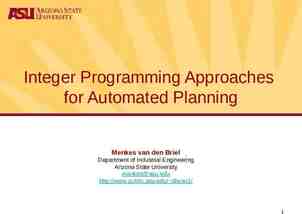Video 1
50 Slides7.24 MB

Video 1

SURVIVING ACTS OF PUBLIC VIOLENCE TRAINING The information contained in this program is straight forward and realistic, it maybe shocking to a few due to its subject matter. But it is for the express purpose of understanding mass shooting and violent incidents and in assisting in keeping as many people safe and uninjured as possible 2 when faced with a violent event.

3

Today We can no longer predict the origin of the next violent threat . Assailants in some incidents across the country were not students, employees, or in any obvious way affiliated with the victims or the location of the shooting. There were no obvious specific targets and the victims were unaware they were

Shooter’s Shoot Everyone! 5

Make no mistake an Active Shooter’s Intent is to Kill and Injure as many people as possible! “Currently active shooters are considered one of the top ten terrorist/criminal threats in America”. 6

Cost in Human Lives The real limit to the cost in human lives in an active shooter incident becomes the density and availability of targets, as long as the victims cannot fight back and as long as the strategy depended upon to stop the shooter is the arrival of law enforcement. With a large group of victims, such as in a large lecture hall with the exits shut, as was done at Virginia Tech, an active shooter might have sufficient targets to kill continuously for the first six minutes, or longer. The sooner the shooter can be contained, captured or neutralized, the fewer the casualties incurred. During the pursuit, police officers will move through unsecured areas, and bypass dead, wounded and panicked citizens while approaching the perpetrator(s) It is important for law enforcement personnel to survive the encounter to end a massacre, rather than become additional victims. Research and Analysis by Montana University 2008

. “Within the span of 16 minutes, the gunmen killed 13 people and wounded 21 others. A savage act of domestic terrorism and mass murder.

There are five phases of the Active Shooter Phenomenon: U.S. Department of Education and U.S. Secret Service Studies 1. Fantasy Stage - During this stage the shooter pictures himself doing the shooting. 2. Planning Stage - In this stage the suspect is deciding on the "who, what, when, where and how" on his day of infamy. 3. Preparation Stage - During this stage the suspect may be obtaining weapons and gun powder for his improvised explosive devices such as pipe bombs 4. Approach Stage - The closer to the event, the more dangerous it will be for any one taking action to stop them. The Approach Stage is a very dangerous stage. The suspect has made his plans and decided to act. They will be walking or riding toward their intended target, ready and armed with any number of devices and weapons. 5. Implementation Stage - Once the shooter opens fire, immediate action needs to be taken. Initial responding officers need to rapidly proceed to the suspect and stop the threat. The Active Shooter will continue to kill until they run out of victims or ammunition.

Anybody can be a shooter! 10

Reacting to a Active Shooter A mass shooting or violent incident can happen anywhere and at any time! Be calm, react, move to safety. Do whatever you need to do to increase your immediate chances of survival . Remember, these instructions are meant as SUGGESTIONS, and are not intended to replace common sense, or be used in preference to instructions or orders from law enforcement authorities at the scene.

Your Survival As tempting as it may be, DO NOT take off running like a chicken with it’s head cut off! 12

Your First Response Run. Hide. Fight. It may feel like just another day of living the America dream. But then something rare happens, life feels more like an action movie than reality. The reality is you may have to face response to a active shooter . and unfortunately, you need to be prepared for the worst. The warning signs may vary, but the devastating effects are the same. If you are to ever find yourself in the middle of an active shooter event, your survival may depend on whether or not you think clearly and 13 have a plan. The plan doesn't have to be

Direct Contact with a Shooter 1. If you are in the same area as the shooter, find cover, fast. Respond to the sound of gunshots according to your situation. Get out of the line of fire anyway you can! 14

Respond to the sound of gunshots according to your situation. 1. It is generally safer to seek cover if directly near the suspect(s) and then move away quickly and stealthily keeping cover between you and the suspect(s) in the opposite direction. *If there is nothing close, simply drop to the floor and lie flat. Lying flat could also make the shooter mistake you for dead. Remain quiet and still if you do so. *Move quietly and quickly when a chance to move to safety becomes apparent. 2. If you see the shooter, running away should be your first plan, when possible. *If they start to shoot as you're making your escape, run in a zigzag or another unpredictable pattern. This will decrease your chances of being shot. *Do not hesitate. Every second counts. Think survival - then act quickly. 3. Seek an exit, or if you have to, hide in a room, preferably with windows, so you have a way of escaping the room if you have to. *Lock or barricade the door and turn off the lights and the ringer on your cell phone. *If a door will not lock, barricade it with tables, chairs, anything. *Assure others to stay calm, that you and the police are working to protect them. Children especially need assurances, do not let someone panic - this could endanger you and others further. 4. If you hear gunshots and are in a room, lock the door or barricade it, turn off the lights, and hide quietly in a place in the room that is out of sight of doors and windows. *If there are others in the room, tell them to stay in the room hiding and to remain very quiet. You shouldn't leave the room since you don't know where the shooter is. *Stay in the room until help arrives and identified themselves. 5. If you get trapped and are face-to-face with a gunman realize that the best response when confronted by an armed assailant is a passive response. Choose escape over attack. Attacking an armed assailant should only be attempted as a very last resort. 6. If you hear gunshots and are outside of a building, go in the opposite direction from where you heard the gunshots. Call emergency services (911) as soon as you are far enough away that you can not hear the gunshots anymore. 7. Wait for help to arrive and stay low and undercover. Before you open the door to someone be aware that it could be the shooter trying to get you to open the door. Ask them questions.

Help Others Help wounded people. If the shooter is not in the vicinity. There are always a lot of these; people that got shot in a non-lethal but nonetheless painful spot will need help. Assess their condition and refer them to the paramedics when they come. Be prepared for some blood. 16

Concealment is KEY! Remember be fast and be quiet!

Concealment is KEY! Remember be fast and be quiet!

Concealment is KEY! Remember be fast and be quiet!

Barricading a Room Pack everything in the room solidly in front of the door. Let NO ONE IN!

Let no one in! 21

Escape or Evacuate Verses Remaining in Place * Evacuate Only When Safe and Appropriate otherwise remain in lockdown mode. Remember – while in lock down, stay away from windows and doors. Remain in place of shelter or safety until instructed to evacuate or leave. 1. Active Shooter: Full Scale Evacuations are Not Recommended as the suspect(s) could be mobile and fluid and often seeks targets of opportunity . 2. Sniper/Barricaded Suspect(s): Remain in place of shelter or safety until instructed to

Unsecured Areas Verses Secured Areas Remember - The shooter will not stop until his/her objectives have been met, unless engaged and stopped by law enforcement. *Consider the risk exposure created by opening a secured door or leaving a secured area. *Attempts to rescue people should only be made if it can be done without further endangering yourself or the persons inside a secured area. *If there is any doubt to the safety of the individuals inside the room, the area needs to remain secured – don’t open the door. *Remember - The shooter may bang on the door and yell for help to entice you to open the door.

Bombings 24

Caught in a Bombing How to react to a bombing really depends on how far away you are from the bomb. If you're near the blast, stay low – there maybe another bomb blast Check yourself for injuries. If your location is unsafe – move to a safe location – find cover Watch out for live wires, spikes, falling objects, etc. Listen for people calling for help. If you see someone who's stuck or can't walk, help or comfort them. You would want the 25

Public Violence and Riots 26

If you can leave the area. During hostile public demonization's – it is a good idea to leave the area or not go near that location. During violent public riots – it is unsafe to go anyplace near the location of any public riots – Stay Away! If you are caught in such an incident leave the area. Immediately get out of the danger area. 27

Hostage If you become a hostage. Stay calm, don’t do anything hostile, wait for rescue or release. In a hostage situation, the most you can probably do is wait for rescue or release. If you're not the only hostage, don't try to be hero. A mistake could just get some of the other hostages, or yourself, killed. Follow instructions. Try to stay calm. Only fight back try to escape if you think there's a good chance of success. Waiting for rescue or release is really your best

A Rule of Survival Don’t try - I’ll talk them out of it! Remember - Do not try to talk to (reason with) or negotiate with someone shooting or making threats with a weapon, even if you know the shooter, stay away! 29

Run Hide and FIGHT if need be! Always choose escape over attack always. Attacking an armed assailant should only be attempted as a very last resort. 30

You have no choice! If it’s Die or Fight, Then Fight! Ok your going to have to Fight, now what! 1. Get as close as possible unnoticed 2. Surprise & Speed – Use them! 3. Use a makeshift weapon – use it HARD! 4. Bring them down fast (balance) 5. Grab for Gun (control) 31

Easy to Remember Tactics 32

A Police Response will be Quick! Rapid Law Enforcement intervention is necessary during these types of events. Containment of the situation, attempted negotiations with the suspects for a peaceful resolution or possibly even violent means may be necessary to save lives. Every second of time you survive 33

This image is what you may first see of the police, lay down, stay down, keeps hands in the open, don’t move and stay quiet!

AWARE OF SECONDARY ATTACKS AND DEVICES! 1. Perpetrator's may act as victims to approach and engage police officers. 2. When an active shooter begins his attack, it is imperative that the initial police responders immediately pursue and establish contact with the shooter at the earliest opportunity. 3. Establishing aggressive action with the active shooter as been the most effective countermeasure in stopping the active killer. The sooner the shooter can be contained, captured or neutralized, the fewer the casualties incurred. 4. During the pursuit, police officers will move through unsecured areas, and bypass dead, wounded and panicked citizens while approaching the armed perpetrator(s).

Police Tactical Responses If terrorists or an active shooter does take over or attack your location (make no mistake, they are terrorists - Domestic or International no matter), you must keep your wits in order – do not panic – THINK Survival . If the situation is a Hostage or Barricaded incident and there is no active attempt by the suspect to take lives, the police will negotiate with the suspect. This will take time and is used to avoid escalation. If the suspect starts injuring or taking lives you can expect a rapid and hostile change in tactics. This will be made perfectly clear to the suspect during negotiations (their safety

Immediate Aftermath & Investigation Information will be released to the community and media as quickly as possible. The entire area will be treated as a crime scene. Once you have been evacuated you will not be permitted to retrieve items or have access the crime scene. After evacuation you will be taken to a police holding area for medical care, interviewing, counseling, etc.

Safety .This is not it!

Proactive Personal Safety & Self Defense To help avoid becoming a victim of a crime of violence when you are out and about or at work, school or play. Always be aware of your safety. Be “proactive” and plan what you would do if you were to encounter 39 possibly dangerous situation.

Becoming Aware of your Surroundings Notice things around you. Are they suspicious in anyway? Be alert – look for risks to your safety! Don’t dismiss something noticed to quickly. This is not about being paranoid – but being safe and limiting your risk. Training in practical knowledge, reason and common sense are reliable tools in assisting you with your continued survival if an act of violence occurs. 40

Public Places Obviously, you can't predict where such a thing will happen, but almost anywhere can be a target area. Sometimes because of the noise, the gunshots may not be audible. The good news is that some type of security and/or police are more likely to be present. 41

Public Places Crowded places. In large groups, is easier for a killer to score dozens of kills with an automatic without specifically aiming at certain people. Uncrowned places. Here, the people you are with are less likely to be hostile or unfriendly. But, if someone does start shooting you're in trouble because the killer is more likely to turn their attention on you very quickly. 42 Crowded and uncrowned places have

A good word about public training During the height of the Cold War 1950’s-1960’s, all American school children were trained for nuclear warfare. As studies showed years later. They were not dramatized by the training in fact it was comforting for American communities to see such training for their children in the public schools. 43

Free On-Line Training The Department of Homeland Security (DHS) has released Active Shooter, What You Can Do (IS-907), a online training course is available through the Federal Emergency Management Agency (FEMA) Emergency Management Institute (EMI) at http://training.fema.gov/EMIWeb/IS/IS907.asp The course is self-paced and takes about 45 minutes to complete 44

U.S. Dept. of HOMELAND SECURITY ACTIVE SHOOTER - HOW TO RESPOND – FREE TRAINING AIDS For liability reasons we recommended that you start with DHS’s FREE training. Materials consist of 3 products:, Basic Guide Book, Break Room Poster, Pocket Emergency Measures Guide To download these materials visit www.dhs.go v/cfsector

“Public Violence is a real challenge for our time. The possibility exists that any one of you might be faced with this challenge in your lives”. .Remember . We can no longer predict the origin of the next threat or attack. Assailants can be anyone from any type of background. The victims were unaware they were targets, until attacked. The shooter will not stop until his/her objectives have been met. “There will be more acts of domestic terrorism and mass violence in the near future”! Prepare now and

Discussion and Questions What if

“It is a mistake to do nothing because you can do so little.” “Do what you can.” 48

Thank You for Your Attention Gregory D. Lilyhorn Subject Matter Expert 2FIVE0 Consulting LLC Contact Information [email protected] or [email protected] Liability & Release Statement: This power point and references is intended only for the use of designated recipient's as a training tool - all rights are reserved by the author Gregory D. Lilyhorn. This training product constitutes no liability with respect to loss, damage, injury or expense arising from any such errors or omission in the contents of this work. Original Copyright

(Resources & References this presentation was based on) U.S Justice Department – Threat Assessment: An Approach To Prevent Targeted Violence, National Institute of Justice, Washington, D.C. USA American Academy of Forensic Sciences - Journal of Forensic Sciences, West Conshohocken, PA. USA U.S. Secret Service –Protective Intelligence Threat Assessment Investigations – National Institute of Justice, Washington, D.C. USA U.S. Department of Homeland Security – Active Shooter Training ISO Program American Society of Industrial Security – Workplace Violence Guidelines U.S. Department of Education and U.S. Secret Service – Mass Violence in Schools Active Shooters Research and Analysis by Montana University 2008 NYPD Active Shooter – Recommendations and Analysis for Risk 50 Mitigation 2012






